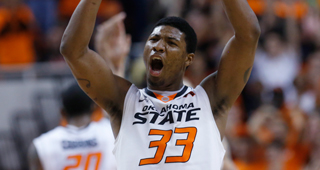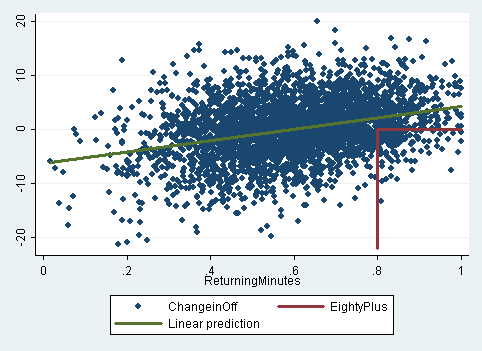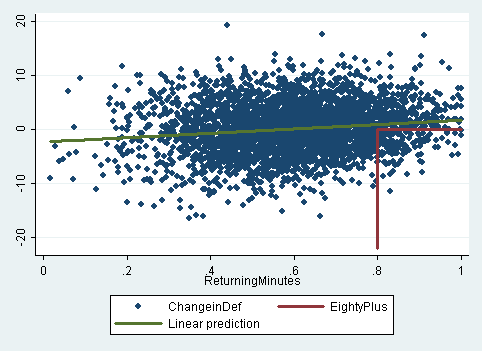The Shove
College basketball was filled with inspired performances this weekend. Michigan St.’s Adreian Payne hit a game-tying three in the final seconds only to watch Wisconsin’s Traevon Jackson hit a game-winning jumper seconds later. Virginia was struggling down one on the road and went on a 22-1 closing run to beat Georgia Tech. Memphis closed with a 10-0 run to edge Gonzaga. Oregon was down 20 to Arizona St., went on an amazing second half run to come back, but still lost by 2. Mississippi’s Marshall Henderson got into a shooting contest with Missouri guards Jabari Brown, Earnest Brown, and Jordan Clarkson, and Ole Miss won thanks to Henderson’s eight threes and 29 points. Jabari Parker Brown went off for 29 points and 16 rebounds. And Iowa St.’s Melvin Ejim topped the weekend with a Big 12 record 48 points.
But despite these inspired performances, it sure feels like the only thing folks will be talking about at the water-cooler on Monday is Oklahoma St.’s Marcus Smart. Smart’s recent shooting slump (documented here by Rob Dauster) is hurting his draft stock, and his team’s poor play is hurting his reputation as a winner. But before this weekend, scouts still pegged him in the lottery due to his size at the PG slot and overall skill set.
Then Smart’s team fell to 4-6 in the Big 12, losing at Texas Tech on Saturday. And if the loss wasn’t painful enough, Smart’s reaction to his team’s struggles in a hostile environment was unacceptable. Smart fell out-of-bounds, got up, and shoved a fan in anger. He earned a technical foul and a three game suspension. Following his chair-kicking incident from a month earlier, Smart now has a big red character flag on his reputation.
I don’t want to spend forever analyzing Smart’s character, whether the suspension was long enough, or the cultural ramifications of a player going into the stands to respond to a fan. Instead I want to ask another question. How does this Oklahoma St.’s season rank in terms of epic disappointments? After all, Oklahoma St. returned a remarkable 89% of its minutes from last year. This was a team that was a co-favorite in the Big 12. And despite bringing basically everyone back, the team sits at 4-6 in the Big 12, the team’s margin-of-victory numbers are worse than last year, and the team’s defense has fallen from 15th nationally to 55th nationally. The Cowboys have given up over one point per possession in six straight games, and in that stretch the team has gone 1-5. But let’s not just stop with Oklahoma St. Let’s ask the bigger question.
How Rare is it For a Team to Bring Everyone Back and Play Worse?
-Harvard returned six players who were starters on either the 2011 or 2012 NCAA tournament team. The Crimson were supposed to dominate the Ivy League and challenge for a high seed in the NCAA tournament. But after losing to Yale this weekend, it isn’t even automatic that they will win the Ivy League. More importantly, Harvard now has some serious questions on offense. In mid-January, Harvard’s margin-of-victory numbers suggested they were a borderline Top 25 team. But after struggling to score in a damaging loss to Florida Atlantic, after a physical Brown defense slowed Harvard down on Friday night, and after Yale’s defense held Harvard down in a loss on Saturday, there are real questions about Harvard’s offensive attack. A team that was 70th and 73rd on offense the last two seasons, currently has the 124th best offense in the nation.
-Boise St. returned 89% of its minutes from a team that made the NCAA tournament last year with great three-point shooting and a lethal 4-guard attack. But after blowing late-game 10 point leads against UNLV and San Diego St., and losing a weekend game at Utah St., Boise St.’s sits at 5-6 in the MWC. And given the league’s poor non-conference showing, Boise St.’s hopes of an at large bid are basically over.
-Boston College returned 95% of its minutes from last year. After finishing 7-6 in their last 13 ACC games last year, and watching Olivier Hanlan emerge into an offensive force, BC seemed poised to make a step forward. Instead the defense has completely collapsed. As noted two weeks ago, Steve Donahue’s team has not adjusted well to the new foul rules. And despite Donahue’s history as a bad defensive coach, this is actually the worst defensive team of his career by a wide margin.
-North Dakota St. returned 95% of its minutes from a team that had the 78th best margin-of-victory numbers in the nation last year. But with losses already to Denver and IPFW in conference play, it took a weekend victory against co-conference leader IPFW for NDSU to even own first place in the Summit league. The big problem is that the team’s defense has fallen off substantially this season. Ranked 59th in the nation last season, NDSU’s defense is now 232nd in the land. And given head coach Saul Phillips’ long-term history on defense, this year’s defensive collapse might not be a fluke.
-Elon returned 95% of its minutes from a team that won its Southern Conference division comfortably. Many pegged them as the favorite over Davidson this year, but their explosive offensive attack couldn’t score at all against Duke’s mediocre defense in December. And with Elon’s defense falling apart, the team sits a disappointing fourth in the league.
-Penn returned an amazing 100% of its minutes from last season, but remains an underwhelming 251st nationally in margin-of-victory, which is actually worse than last season. Despite a nice win over Columbia over the weekend, the long-term power numbers suggest Penn is long-shot to finish above .500 in the Ivy League, let alone win the conference. This was probably best exemplified by the teams 30 point loss to Harvard the previous weekend.
When you read a list like that, it is fair to ask whether this might be the most disappointing group of veteran teams college basketball has ever seen. Of course there are extenuating circumstances:
-Oklahoma St. lost Michael Cobbins to injury and there is no question that the team’s defensive collapse coincides with his injury. Kamari Murphy has fouled out or been in foul trouble in six straight games. And Travis Ford basically refused to play former Top 100 JUCO forward Gary Gaskins or the 7-foot Marek Soucek. Without adequate size in the paint, Oklahoma St. simply can’t keep quality teams from scoring in the paint.
-Boise St. hasn’t actually been playing terrible basketball. There numbers are actually very similar to last year. But the difference between winning close games in the fifth best league and losing close games in the tenth best league means everything for at-large consideration.
-North Dakota St.’s three point percentage on defense (40% against) and the free throw percentage on defense (76% against) are much worse than last year. Both of those are things that the defense has limited control over. So perhaps the epic collapse on defense is a little bit of a fluke.
Still, almost every team will face some adversity in a season. Shouldn’t these veteran squads be better equipped to overcome that? Is returning minutes no longer the strong predictor it used to be? To answer that question let’s go to the data. The next two tables shows the returning minutes for ever D1 team from 2004 to 2013 along the X-axis.
The first figure below graphs the change in adjusted offense from one season to the next based on returning minutes. As the fitted line shows, as a team returns more minutes, its offense is more likely to improve.
The second figure shows the change in adjusted defense. Again, the more minutes a team brings back, the bigger the improvement you should expect on defense. (Generally, you want the defensive rating to decrease, but I flipped the sign so it would be more easy to compare the offense and defense. The comparison shows that returning minutes have a bigger impact on a team’s offense than a team’s defense.)
Yet despite the general correlation, I want to emphasize that bringing everyone back does not guarantee anything. Look closely at the area I have emphasized in red in the lower-right hand corner of both graphs. From 2004-2013, a significant number of teams that returned over 80% of their minutes got worse on either offense or defense. While the experience of Oklahoma St., Harvard, Boston College, and others is unlikely, it is far from rare.
Talent vs Experience
The beauty of the NCAA tournament is often the clash between experience and talent. Will a plucky mid-major squad filled with experienced seniors be able to defeat a young power conference team? And we spend a lot of time nit-picking the youth of talented teams like Kansas and Kentucky. The above analysis shows that maybe we should spend some time nit-picking some of these experienced mid-major squads too.
But for a team like Oklahoma St., the struggles are particularly painful. The Cowboys not only had experience, they supposedly had talent. Marcus Smart was a lottery pick. Markel Brown has been playing All-Big 12 caliber basketball for much of the season. Phil Forte had solved the team’s three point shooting problems. LeBryan Nash has substantially improved his rebounding. The offense is better, and if the defense could have simply matched last year’s form, the Final Four was easily within reach. Even if this isn’t the first team to bring everyone back and play worse basketball, for Oklahoma St. fans, that is probably not much of a consolation.





